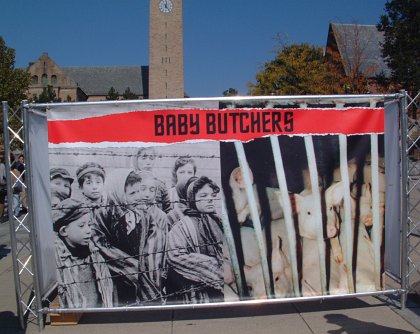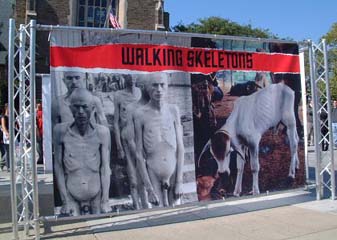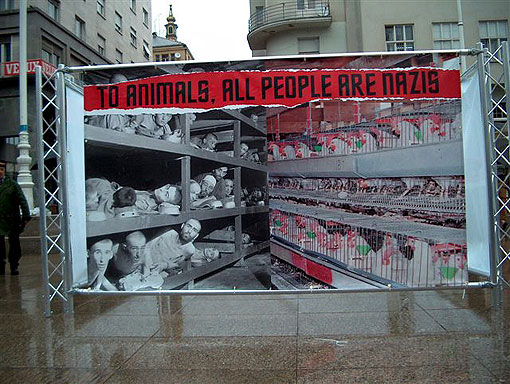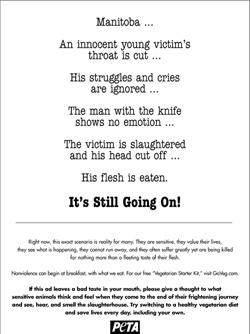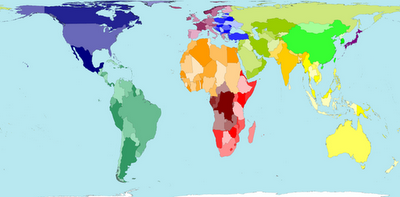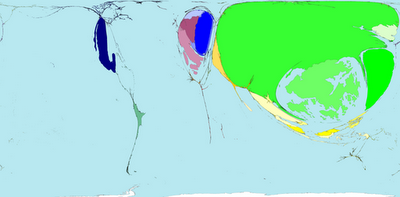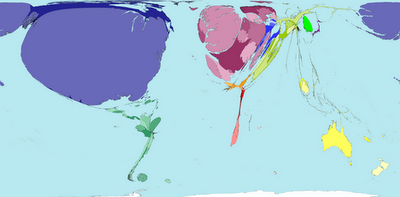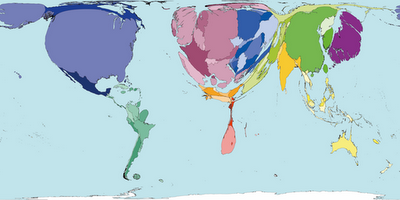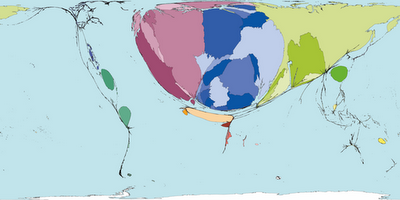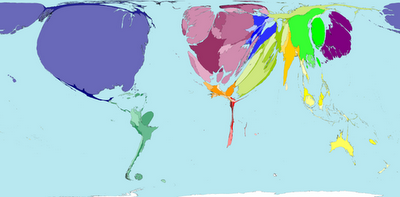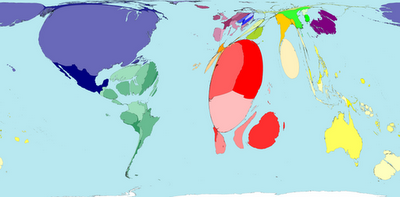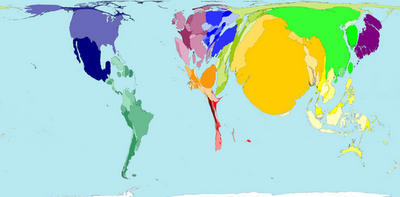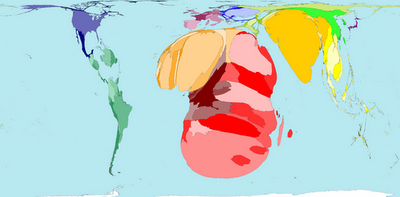Thanks again, p.j.!
war/military
Here are two videos from MTV’s Think campaign (both found here):
I am not at all sure what the message is here–just a general “fear your government” warning? A comment on the Bush Administration’s policies? The Patriot Act? Also note that the message is that the Holocaust happened to people like us–not that it was done by people like us, which might be a more interesting message.
Anyway, I think this could be compared to the PETA posters in a discussion about history and who has the right to use it how. Will everyone see these images as offensive? Is any use of the Holocaust as an example or comparison automatically offensive? Would campaigns that use the Holocaust be as offensive to people if they used the genocide in Rwanda instead? Who gets to claim the right to use images and symbols of historical events, including horrible tragedies, and in what ways can they use them?
Thanks to Simone for pointing these out!
These images were all used (along with lots of others) in a 2003 campaign in which PETA, obviously, compared modern agricultural practices and eating meat with the Holocaust:
Found here.
Found here.
Found here.
I assume it will not surprise anyone to learn that many people were offended by the campaign. I can imagine using these images in courses on food/agriculture, social movements, natural resources and the environment (especially in discussions of what rights non-human animals have), and even lectures about historical memory (for instance, when and how does it become acceptable to use historical tragedies like the Holocaust as symbols in other arguments, rather than as events in and of themselves?).
Thanks to an anonymous poster for pointing this campaign out!
NEW: Elizabeth (from Blog of Stench) sent in this ad (found here) PETA apparently attempted to run in the Portage Daily Graphic in Manitoba, Canada:
The ad references an incident on a bus in Manitoba where a man beheaded a fellow passenger and compares it to the slaughtering of animals.
Thanks, Elizabeth!
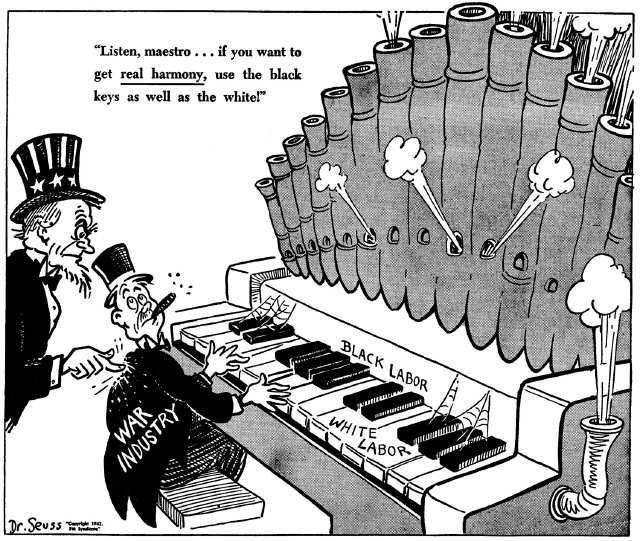
Found here.
Kate N. pointed us towards this article in the New York Times today discussing 25 years of Marines recruitment aimed at women. Below is the content of their slide show.
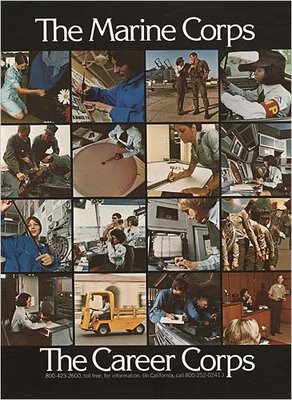
1976: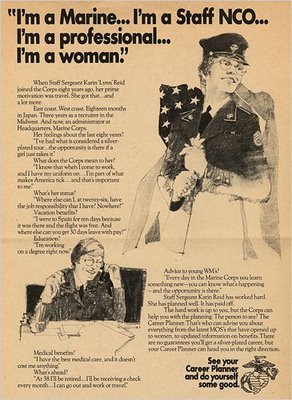
1978: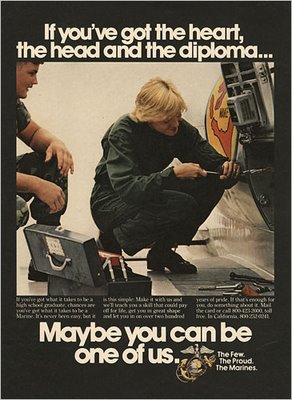
1980: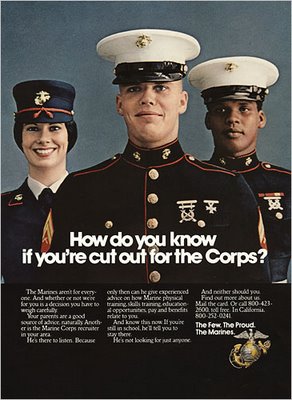
1984:
1988: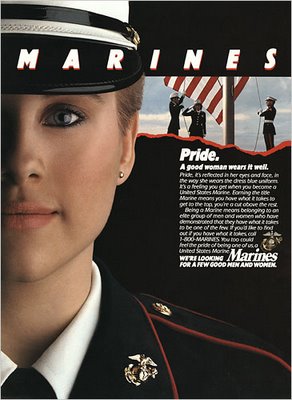
1995: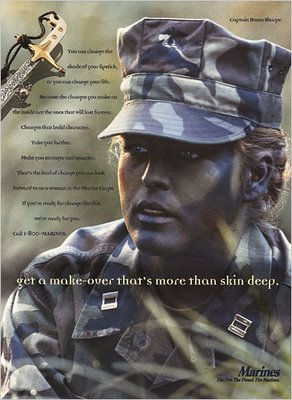
1995: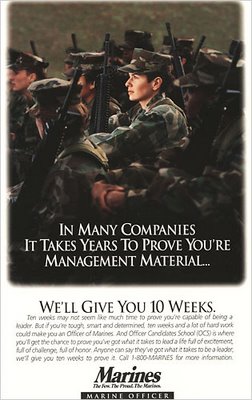
2000: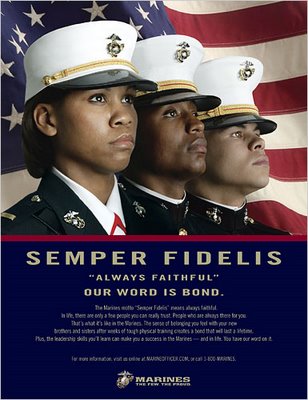
2000: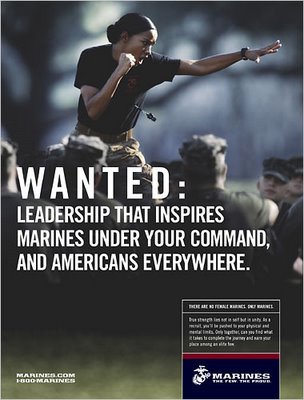
The article says that the Marines have only recently began a concerted attempt to recruit women. Does anyone have any information about the shift in the racial targeting? Or is that just an artifact of the slide show?
Thanks so much for the tip, Kate!
Also in military recruitment: which military would you join?, the homefront, and war as entertainment.
.
Worldmapper offers maps in which the actual land area is morphed to represent various disproportionalities across the globe. The website has over 300 maps! Thanks 73man for the tip!
I borrowed a few examples and pasted them in below. The first map is an actual land area map for reference.
Territory size shows the proportion of worldwide net exports of toys (in US$) that come from there. Net exports are exports minus imports. When imports are larger than exports the territory is not shown.
Territory size shows the proportion of worldwide net imports of toys (in US$) that are received there. Net imports are imports minus exports. When exports are larger than imports the territory is not shown.
Territory size shows the proportion of carbon dioxide emissions in 1980 that were directly from there.
Territory size shows the proportion of all territory level decreases in carbon dioxide emissions between 1980 and 2000, that occurred there.
Territory size shows the proportion of state military spending worldwide that was spent by that territory in 2002.
Territory size shows the proportion of species worldwide that became extinct between 1500 current era and 2004, that became extinct there.
Territory size shows the proportion of all people over 15 in the world living with diabetes who live there.
Territory size shows the proportion of all people aged 15-49 with HIV (Human Immunodeficiency Virus) worldwide, living there.
See more alternative maps here.
.
Here is the trailer for Resident Evil 5, which is not yet on the market:
The player is the sole white person in a dismal, threatening city, apparently in Africa. The locals engage in torture (which we see in some detail) and gleefully cheer at a hanging. At one point the hero is accosted by an angry mob, all of whom just make gutteral, animal-like sounds. In a beleagured voice he tells us he just doesn’t know “if it’s all worth fighting for. Who knows?” Oh, the white man’s burden, indeed!
Thanks once again, Patrick C.!
Jeff G. sent in links to several articles about the game, if you’re interested. Here’s one with the director, and here’s an article about a British government censorship agency officially ruling the game isn’t racist.
NEW! Ryan sent in an image of a character from the game:

Ryan points out it’s another example of non-White women being portrayed as exotic or animalistic. Thanks for the image!
This quick video presents an American and a Swedish military recruitment commercial back-to-back.
Our member blogger, Wendy, who is writing her dissertation on the military, had this to say:
The most striking difference between these ads to me is what these commercials choose to show and what they don’t show to recruit new members.
The Marines’ commercial focuses on the duty, bravery, glory, honor aspects of service. And this is entirely focused inward– toward the Marines and the country’s goals (and in that order– Marines’ loyalties are to “unit, Corps, God and country” in that order). Where is the “other” in this commercial (that is such a part of the Sweden commercial)? Who is the “for honor” for? Who is the “for courage” for? It seems implicitly to be to the corps.
This is right in line with most Marine discourse. All of their recruitment info is the same– the focus is on the corps, and on the highly specialized ways Marines serve. As a popular Marine slogan says “The USMC: When it absolutely, positively must be destroyed overnight.”
And the Swedish commercial is even more fascinating. There is no focus on the actual members of the Nordic Battlegroup. Instead it is all about everyday people– both in Sweden and in countries experiencing conflict. The focus is on the privilege of living in a country not at war (”everybody’s everyday is not like ours”).
The images of war in this commercial are disturbing– hectic, scary and out of control. This is the exact opposite of the Marine commercial where everything is ordered and organized and machines (helicopters, guns) are shown as extension of this order and control– instead of in a context of chaos. There’s a HUGE disconnect between the weapons shown and what they actually DO during war.
War in all its chaos is present in the Swedish commercial, and absent from the Marines commercial. That in and of itself is interesting.
Via Spiked Humor
Thanks to Julie C. for this tip!
Here are two videos from MTV’s Think campaign (both found here):
I am not at all sure what the message is here–just a general “fear your government” warning? A comment on the Bush Administration’s policies? The Patriot Act? Also note that the message is that the Holocaust happened to people like us–not that it was done by people like us, which might be a more interesting message.
Anyway, I think this could be compared to the PETA posters in a discussion about history and who has the right to use it how. Will everyone see these images as offensive? Is any use of the Holocaust as an example or comparison automatically offensive? Would campaigns that use the Holocaust be as offensive to people if they used the genocide in Rwanda instead? Who gets to claim the right to use images and symbols of historical events, including horrible tragedies, and in what ways can they use them?
Thanks to Simone for pointing these out!
These images were all used (along with lots of others) in a 2003 campaign in which PETA, obviously, compared modern agricultural practices and eating meat with the Holocaust:
Found here.
Found here.
Found here.
I assume it will not surprise anyone to learn that many people were offended by the campaign. I can imagine using these images in courses on food/agriculture, social movements, natural resources and the environment (especially in discussions of what rights non-human animals have), and even lectures about historical memory (for instance, when and how does it become acceptable to use historical tragedies like the Holocaust as symbols in other arguments, rather than as events in and of themselves?).
Thanks to an anonymous poster for pointing this campaign out!
NEW: Elizabeth (from Blog of Stench) sent in this ad (found here) PETA apparently attempted to run in the Portage Daily Graphic in Manitoba, Canada:
The ad references an incident on a bus in Manitoba where a man beheaded a fellow passenger and compares it to the slaughtering of animals.
Thanks, Elizabeth!

Found here.
Kate N. pointed us towards this article in the New York Times today discussing 25 years of Marines recruitment aimed at women. Below is the content of their slide show.

1976:
1978:
1980:
1984:
1988:
1995:
1995:
2000:
2000:
The article says that the Marines have only recently began a concerted attempt to recruit women. Does anyone have any information about the shift in the racial targeting? Or is that just an artifact of the slide show?
Thanks so much for the tip, Kate!
Also in military recruitment: which military would you join?, the homefront, and war as entertainment.
.
Worldmapper offers maps in which the actual land area is morphed to represent various disproportionalities across the globe. The website has over 300 maps! Thanks 73man for the tip!
I borrowed a few examples and pasted them in below. The first map is an actual land area map for reference.
Territory size shows the proportion of worldwide net exports of toys (in US$) that come from there. Net exports are exports minus imports. When imports are larger than exports the territory is not shown.
Territory size shows the proportion of worldwide net imports of toys (in US$) that are received there. Net imports are imports minus exports. When exports are larger than imports the territory is not shown.
Territory size shows the proportion of carbon dioxide emissions in 1980 that were directly from there.
Territory size shows the proportion of all territory level decreases in carbon dioxide emissions between 1980 and 2000, that occurred there.
Territory size shows the proportion of state military spending worldwide that was spent by that territory in 2002.
Territory size shows the proportion of species worldwide that became extinct between 1500 current era and 2004, that became extinct there.
Territory size shows the proportion of all people over 15 in the world living with diabetes who live there.
Territory size shows the proportion of all people aged 15-49 with HIV (Human Immunodeficiency Virus) worldwide, living there.
See more alternative maps here.
.
Here is the trailer for Resident Evil 5, which is not yet on the market:
The player is the sole white person in a dismal, threatening city, apparently in Africa. The locals engage in torture (which we see in some detail) and gleefully cheer at a hanging. At one point the hero is accosted by an angry mob, all of whom just make gutteral, animal-like sounds. In a beleagured voice he tells us he just doesn’t know “if it’s all worth fighting for. Who knows?” Oh, the white man’s burden, indeed!
Thanks once again, Patrick C.!
Jeff G. sent in links to several articles about the game, if you’re interested. Here’s one with the director, and here’s an article about a British government censorship agency officially ruling the game isn’t racist.
NEW! Ryan sent in an image of a character from the game:

Ryan points out it’s another example of non-White women being portrayed as exotic or animalistic. Thanks for the image!
This quick video presents an American and a Swedish military recruitment commercial back-to-back.
Our member blogger, Wendy, who is writing her dissertation on the military, had this to say:
The most striking difference between these ads to me is what these commercials choose to show and what they don’t show to recruit new members.
The Marines’ commercial focuses on the duty, bravery, glory, honor aspects of service. And this is entirely focused inward– toward the Marines and the country’s goals (and in that order– Marines’ loyalties are to “unit, Corps, God and country” in that order). Where is the “other” in this commercial (that is such a part of the Sweden commercial)? Who is the “for honor” for? Who is the “for courage” for? It seems implicitly to be to the corps.
This is right in line with most Marine discourse. All of their recruitment info is the same– the focus is on the corps, and on the highly specialized ways Marines serve. As a popular Marine slogan says “The USMC: When it absolutely, positively must be destroyed overnight.”
And the Swedish commercial is even more fascinating. There is no focus on the actual members of the Nordic Battlegroup. Instead it is all about everyday people– both in Sweden and in countries experiencing conflict. The focus is on the privilege of living in a country not at war (”everybody’s everyday is not like ours”).
The images of war in this commercial are disturbing– hectic, scary and out of control. This is the exact opposite of the Marine commercial where everything is ordered and organized and machines (helicopters, guns) are shown as extension of this order and control– instead of in a context of chaos. There’s a HUGE disconnect between the weapons shown and what they actually DO during war.
War in all its chaos is present in the Swedish commercial, and absent from the Marines commercial. That in and of itself is interesting.
Via Spiked Humor
Thanks to Julie C. for this tip!






